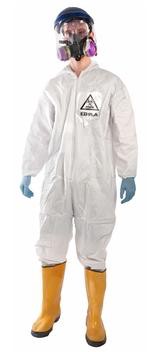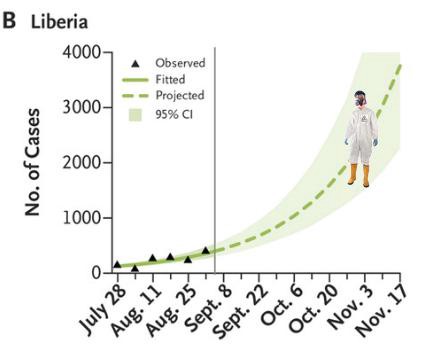Your Ebola Halloween Costume: A User's Guide

So you’re doing “Ebola” for your halloween costume this year. You’ve found a topical novelty outfit online, or maybe you’ve just purchased some cheap and readily available medical clothing, knowing that your peers will have no problem guessing what it’s supposed to represent.
But “Ebola” is going to be a very popular costume this year. You’re not the only person who heard about this epidemic on the news! If you want to stand out — if you want to be the star of the party, by evoking Ebola hemorrhagic fever — you need to study up. Here are some helpful facts that you can recite to your friends in order to give your Ebola costume that extra dimension of authenticity.
• Ebola kills quickly and painfully. There is no known cure, or vaccine, and the best available treatment in most cases, according to the CDC, is “providing intravenous fluids (IV) and balancing electrolytes (body salts).”
• Ebola is characterized, early on, by fever, weakness, headache and diarrhea. This is followed by hemorrhaging and near-total loss of responsiveness.
• Direct contact with infected patients is the primary mode of transmission for Ebola. Therefore, this disease is most dangerous to the people who choose to provide treatment to the afflicted. Many, many medical professionals have died trying to give care and slow the spread of this terrifying disease.
• Ebola has spread most profoundly in Guinea, Liberia, and Sierra Leone, where a paucity of medical and emergency infrastructure has allowed the disease to spiral out of control. (Don’t worry: These places are all at least 4,000 miles away from the nearest American Halloween parties.) Facilities that do exist have been largely overwhelmed, creating hellish scenes of suffering.
• Many of the people fighting this disease do not have access to necessary PPE (Personal Protective Equipment) — equipment that you will be wearing, either in real or replicate form, to a sports bar or fraternity party on October 31st. (Careful: The CDC says that proper PPE “significantly reduces the body’s normal way of getting rid of heat by sweating,” increasing the risk of dehydration and heat-related illnesses.)
• Speaking of October 31st: That’s a date by which the WHO estimates that well over 20,000 people will have been infected with the disease:
As of September 14, the doubling time of the epidemic was 15.7 days in Guinea, 23.6 days in Liberia, and 30.2 days in Sierra Leone. We estimate that, at the current rate of increase, assuming no changes in control efforts, the cumulative number of confirmed and probable cases by November 2 (the end of week 44 of the epidemic) will be 5740 in Guinea, 9890 in Liberia, and 5000 in Sierra Leone, exceeding 20,000 cases in total. The true case load, including suspected cases and undetected cases, will be higher still.
• To provide more visual context to other partygoers, you can show them this image. That’s you in the suit. You have been superimposed over the WHO’s projection for Ebola infections in Liberia at Halloween-time, approximately.

• Ebola has killed 4493 people as of writing. But by the time it’s time to dress up for Halloween, that number will be out of date. Don’t give the other partygoers the wrong info: Before suiting up, check again. (Current estimates suggest that the number of deaths will have doubled.)
• Use anecdotes to really drive home your costume concept. Here, a photojournalist describes what the epidemic looks like on the ground:
In one of the most emotional encounters I faced in Liberia, I photographed a family that accompanied a sick woman who seemed near death as they sought treatment. She was bleeding from the mouth and her breathing was shallow; she was not ambulatory. As the husband, a sister, a brother and a friend descended from the van, each wore large plastic bags around their hands, feet and bodies, trying to protect themselves from infection with makeshift coverings. They knew it was the only way to get their very ill relative to the Doctors Without Borders Ebola treatment unit. Waiting outside the gates was a given, but to the anxious family, I am sure one hour seemed far too long as the patient worsened.
An alternative plan: For supreme costume authenticity, quarantine yourself in your home for 24 hours starting on Halloween morning.
